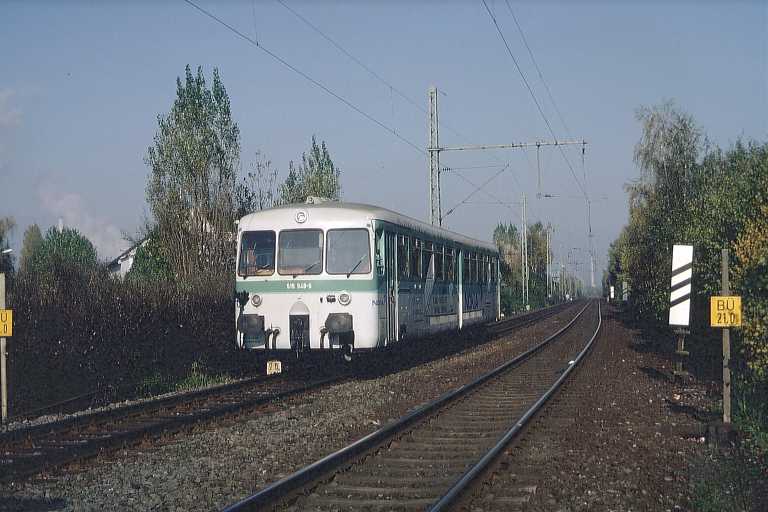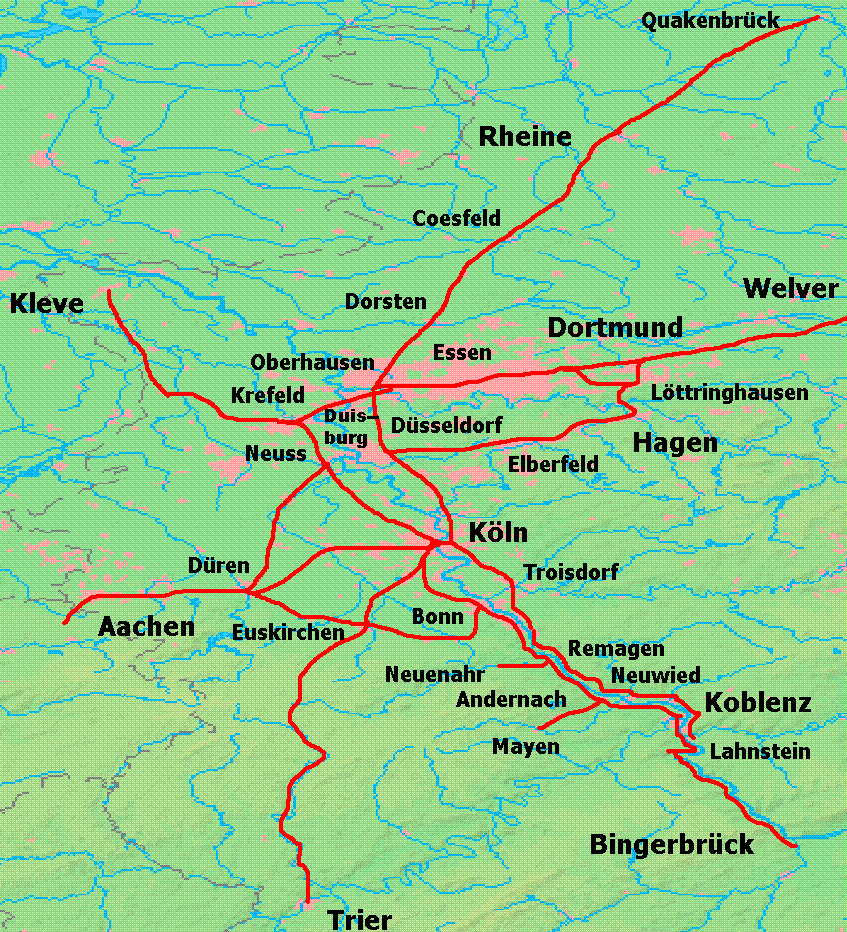|
Bochum–Gelsenkirchen Railway
The Bochum–Gelsenkirchen railway, also known as the Glückauf-Bahn (referring to Glück auf, the traditional German miners greeting), is a passenger railway from Bochum Central Station (''Hauptbahnhof'') to Gelsenkirchen Central Station in the German state of North Rhine-Westphalia. It is served by Regionalbahn passenger service RB 46). It is also used by freight traffic from Bochum freight yard at the former Bochum Süd station and Bochum-Präsident to Gelsenkirchen-Schalke Nord. The line was built in sections between 1867 and 1876 of the Bergisch-Märkische Railway Company. The curve connecting to Bochum Central Station was opened in 1979. Passengers Until 1978, the Deutsche Bundesbahn passenger service ran from Bochum-Langendreer via Bochum-Nord, Bochum- Riemke to Wanne-Eickel (see Bochum-Riemke–Wanne-Eickel line below). After the construction of a connecting curve from Bochum Central Station (''Hauptbahnhof'') to the line towards Riemke in 1979, passenger services ... [...More Info...] [...Related Items...] OR: [Wikipedia] [Google] [Baidu] |
North Rhine-Westphalia
North Rhine-Westphalia (german: Nordrhein-Westfalen, ; li, Noordrien-Wesfale ; nds, Noordrhien-Westfalen; ksh, Noodrhing-Wäßßfaale), commonly shortened to NRW (), is a States of Germany, state (''Land'') in Western Germany. With more than 18 million inhabitants, it is the List of German states by population, most populous state of Germany. Apart from the city-states, it is also the List of German states by population density, most densely populated state in Germany. Covering an area of , it is the List of German states by area, fourth-largest German state by size. North Rhine-Westphalia features 30 of the 81 German municipalities with over 100,000 inhabitants, including Cologne (over 1 million), the state capital Düsseldorf, Dortmund and Essen (all about 600,000 inhabitants) and other cities predominantly located in the Rhine-Ruhr metropolitan area, the largest urban area in Germany and the fourth-largest on the European continent. The location of the Rhine-Ruhr at the h ... [...More Info...] [...Related Items...] OR: [Wikipedia] [Google] [Baidu] |
DB Class 628
The DB Class 628 is a twin-car, diesel multiple unit operated by the Deutsche Bahn for local passenger rail services. Design ''(The following description is primarily related to the Class 628.4, and is largely valid for the other variants as well)'' Each coach rests on two twin-axle bogies. Only the bogie at the close-coupled end of the coach is driven. Power transmission from the motor is achieved using a ''Voith'' hydrodynamic transmission system with a converter (''Wandler'') and a T 311r coupling. Up to Class 628, a T 320 double-converter transmission was used. Motor and transmission are suspended elastically under the lightweight coach body. The operating brake is an automatic compressed air KE disc brake with automatic load braking and electronic anti-skid protection. In addition, for rapid braking, electromagnetic rail brakes are used; these can also be activated separately if required. Coupled running enables up to four coupled pairs of coaches to be driven from one dri ... [...More Info...] [...Related Items...] OR: [Wikipedia] [Google] [Baidu] |
Railway Lines In North Rhine-Westphalia
Rail transport (also known as train transport) is a means of transport that transfers passengers and goods on wheeled vehicles running on rails, which are incorporated in tracks. In contrast to road transport, where the vehicles run on a prepared flat surface, rail vehicles (rolling stock) are directionally guided by the tracks on which they run. Tracks usually consist of steel rails, installed on sleepers (ties) set in ballast, on which the rolling stock, usually fitted with metal wheels, moves. Other variations are also possible, such as "slab track", in which the rails are fastened to a concrete foundation resting on a prepared subsurface. Rolling stock in a rail transport system generally encounters lower frictional resistance than rubber-tyred road vehicles, so passenger and freight cars (carriages and wagons) can be coupled into longer trains. The operation is carried out by a railway company, providing transport between train stations or freight customer facilit ... [...More Info...] [...Related Items...] OR: [Wikipedia] [Google] [Baidu] |
Osterath–Dortmund Süd Railway
The Osterath–Dortmund-Süd railway is a historically significant line in the German state of North Rhine-Westphalia. Parts of it are closed, much of it is now used for freight only, but several sections are still used for Regional-Express, Regionalbahn or Rhine-Ruhr S-Bahn services. The nearly 76 kilometre long line was built in three stages between 1866 and 1874 by the Rhenish Railway Company (german: Rheinische Eisenbahn-Gesellschaft, RhE), creating a third major east-west line through the Ruhr area. It was intended to compete effectively with the established and profitable lines of its competitors—the Duisburg–Dortmund railway, Duisburg–Dortmund line of the Cologne-Minden Railway Company and the Witten/Dortmund–Oberhausen/Duisburg railway, Ruhr line of Bergisch-Märkische Railway Company, but it was not successful. History The Rhenish Railway concentrated for a long time left on the territories next to the Rhine, leaving the Ruhr area with its coal mines and emergi ... [...More Info...] [...Related Items...] OR: [Wikipedia] [Google] [Baidu] |
Rhenish Railway Company
The Rhenish Railway Company (German language, German: ''Rheinische Eisenbahn-Gesellschaft'', RhE) was along with the Cologne-Minden Railway Company (CME) and the Bergisch-Märkische Railway Company (BME) one of the railway companies that in the mid-19th century built the first railways in the Ruhr and large parts of today's North Rhine-Westphalia. Foundation The industrialists of the Rhineland and the Bergisches Land, then part of Prussia, sought to avoid paying the high tolls for using the Rhine imposed by the Netherlands and very early in its development, saw the possibility of the new means of transport, the railway. As early as the 1830s committees were established the cities of the Rhineland to promote proposals for building railways. Some of the members of the Cologne committee under David Hansemann (1790–1864)—a merchant and banker from Aachen—and the Aachen Committee favoured a railway line through Belgium to the seaport of Antwerp via Liege. Belgium, which had bee ... [...More Info...] [...Related Items...] OR: [Wikipedia] [Google] [Baidu] |
Katholikentag
''Katholikentag'' () is a festival-like gathering in German-speaking countries organized by laity of the Catholic Church. ''Katholikentag'' festivals occur approximately every 2–4 years in Germany, Switzerland, and Austria. ''Katholikentag'' in Germany History The first official Katholikentag festival was organized by Adam Franz Lennig and held in Mainz from 3 to 6 October 1848. The idea was a "general assembly of Catholic society in Germany" (''Generalversammlung des katholischen Vereins Deutschlands''), originally intended for delegates of the Catholic Church in Germany. The 87 delegates and about 100 visitors met with the aim of improving relations between the Catholic Church in Germany and the German government. During the ensuing decades the Katholikentags increased in popularity and fame. They became an opportunity for Catholics to discuss and celebrate their faith. Since then, the Roman Catholic Church in Germany has become one of a set of state religions. Katholikentag ... [...More Info...] [...Related Items...] OR: [Wikipedia] [Google] [Baidu] |
Essen Central Station
Essen Hauptbahnhof (German for "Essen main station") is a railway station in the city of Essen in western Germany. It is situated south of the old town centre, next to the A 40 motorway. It was opened in 1862 by the Bergisch-Märkische Eisenbahn. However, the station was not the first in Essen: as the station called ''Essen'' (today Essen-Altenessen) on the Köln-Mindener Eisenbahn was opened in 1847. The station suffered extensive damage in World War II and was almost completely rebuilt in the 1950s and 1960s. During the following years, the Essen Stadtbahn and the A 40 were other construction projects affecting the station. Today it is an important hub for local, regional and long-distance services, with all major InterCityExpress and InterCity trains calling at the station as well as RegionalExpress and Rhein-Ruhr S-Bahn services. Trains of all kinds call at the station, from long distance to local services. It used to be one of the Metropolitan stops on the Hamburg to Co ... [...More Info...] [...Related Items...] OR: [Wikipedia] [Google] [Baidu] |
Oberhausen Central Station
Oberhausen Hauptbahnhof is a railway station in Oberhausen, North Rhine-Westphalia, Germany. The station was opened in 1847 and is located on the Duisburg–Dortmund railway, Arnhem-Oberhausen railway, Oberhausen–Duisburg-Ruhrort railway and Oberhausen-Mülheim-Styrum railway and is served by ICE, IC, RE and RB services operated by Deutsche Bahn, Abellio Deutschland, NordWestBahn and Eurobahn. History The station was opened in 1847 as part of the trunk line of the former Cologne-Minden Railway Company. The first station building at its present location—a simple half-timbered building and loading facility—was named after the nearby Schloss Oberhausen (palace) and opened on 15 May 1847. It was the first station on the territory of the former Bürgermeisterei of Borbeck; the city of Oberhausen did not exist at this time. The station initially serviced the developing heavy industry, centred on the ''Gutehoffnungshütte'' steel works. The entrepreneur Franz Haniel had in ... [...More Info...] [...Related Items...] OR: [Wikipedia] [Google] [Baidu] |
Frederick III, German Emperor
Frederick III (german: Friedrich Wilhelm Nikolaus Karl; 18 October 1831 – 15 June 1888), or Friedrich III, was German Emperor and King of Prussia for 99 days between March and June 1888, during the Year of the Three Emperors. Known informally as "Fritz",MacDonogh, p. 17. he was the only son of Emperor Wilhelm I and was raised in his family's tradition of military service. Although celebrated as a young man for his leadership and successes during the Second Schleswig, Austro-Prussian and Franco-Prussian wars,Kollander, p. 79.''The Illustrated London News'' he nevertheless professed a hatred of warfare and was praised by friends and enemies alike for his humane conduct. Following the unification of Germany in 1871 his father, then King of Prussia, became the German Emperor. Upon Wilhelm's death at the age of ninety on 9 March 1888, the thrones passed to Frederick, who had been German Crown Prince for seventeen years and Crown Prince of Prussia for twenty-seven years. Freder ... [...More Info...] [...Related Items...] OR: [Wikipedia] [Google] [Baidu] |

.jpg)
.jpg)




